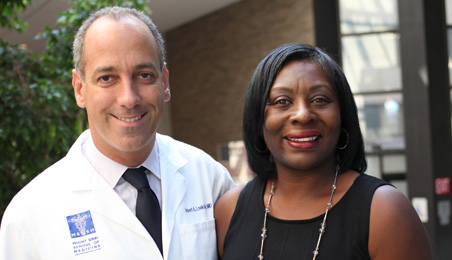Uterine Fibroid Embolization Minimally Invasive Alternative
I am a former patient of Mount Sinai's Division of Interventional Radiology, and I highly recommend the department for any person who needs any of the treatments listed on their website. I make such a bold statement because I received outstanding care and was treated like a princess by every staff person who interacted with me during the process. If you choose Interventional Radiology, I am positive that you will be treated the same way.
 I sought treatment at Mount Sinai on the recommendation of a very, very good friend. When I came to Mount Sinai for my consultation, I came with the cloud of a pending hysterectomy hanging over my head. My stomach was distended (it looked like I was at least six months pregnant and my uterus had developed several fibroids, one of which was extremely large). My female gynecologist had recommended a hysterectomy as my only medical option. To say I was extremely distraught about the highly invasive surgery and the resulting minimum six-week recovery time is an understatement.
I sought treatment at Mount Sinai on the recommendation of a very, very good friend. When I came to Mount Sinai for my consultation, I came with the cloud of a pending hysterectomy hanging over my head. My stomach was distended (it looked like I was at least six months pregnant and my uterus had developed several fibroids, one of which was extremely large). My female gynecologist had recommended a hysterectomy as my only medical option. To say I was extremely distraught about the highly invasive surgery and the resulting minimum six-week recovery time is an understatement.
The Consultation: A Minimally Invasive Alternative
During my consultation with Robert Lookstein, MD, and Julie Fung, PA, I was given a clear, easily understood explanation of a minimally invasive alternative, uterine fibroid embolization (UFE). Both medical professionals assured me that I was an ideal candidate, explained the benefits, what I could expect after the procedure, and how the procedure would correct my condition. They also provided an in-depth explanation about how the procedure is performed. No medical jargon, just a straightforward, easy to understand without a Physician's Desk Reference, explanation. Based upon their wealth of experience and admirable medical skill, they were more than accurate.
The Uterine Fibroid Embolization Procedure and Recovery
I scheduled my UFE for March 29, 2013. I was admitted promptly, efficiently prepared for my procedure, and taken to the surgery suite. Thankfully, I don't recall much about the procedure (anesthesia is one of medical science's most outstanding discoveries), but I vividly recall the recovery period.
During the recovery period, each medical professional that helped me, from the nurses, recovery room physician and all others, treated me with care and compassion. Each individual who spoke to me during the recovery period made sure I was comfortable. They watched me, fed me, and made me feel that my recovery was their paramount concern.
I experienced minimal pain during the recovery period after my procedure. I didn't need or use the pain pump that was provided. I didn't experience ANY cramping after the procedure (cramping is pretty common immediately after a UFE) or during my 20-plus mile ride home. I really didn't experience any real discomfort until much later that day. And that discomfort was alleviated by some sleep. (It should be noted that I was supplied with prescriptions for any of the possible pain scenarios and antibiotics. Fortunately, I didn't need the pain medication for longer than 1/2 a day). By Saturday afternoon on March 30, I was ready to resume my regular activities, including exercise.
The Results
I had my six-month follow-up on Tuesday, August 6. The results were astounding. My two smaller uterine fibroids were not visible on the MRI image and the largest fibroid has shrunk by at least half, if not more. It is anticipated that the largest fibroid will shrink even more within the next three months.
This entire story is a testimony to the care, skill, and professionalism of the Interventional Radiology staff. Thanks to them, I was able to avoid major surgery. Special thanks to Dr. Lookstein and Julie Fung for recognizing that UFE would correct my problem. But my thanks would be incomplete if I did not thank all of the caring people who were involved in my process.
--Loren